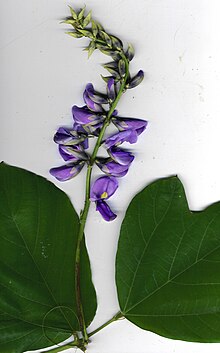| Pueraria montana var. lobata | |
|---|---|

| |
| Scientific classification | |
| Kingdom: | Plantae |
| Clade: | Tracheophytes |
| Clade: | Angiosperms |
| Clade: | Eudicots |
| Clade: | Rosids |
| Order: | Fabales |
| Family: | Fabaceae |
| Subfamily: | Faboideae |
| Genus: | Pueraria |
| Species: | |
| Variety: | P. m. var. lobata
|
| Trinomial name | |
| Pueraria montana var. lobata (Willd.) Maesen & S. M. Almeida ex Sanjappa & Predeep
| |
| Synonyms[1] | |
|
List
| |
Pueraria montana var. lobata, the East Asian arrowroot, or kudzu vine,[2] is a perennial plant in the family Fabaceae.
Names[edit]
It is called gé (葛) in Chinese, kuzu (クズ, 葛)[3] in Japanese, and chik (칡) or gal (갈; 葛) in Korean.
Distribution[edit]
The plant is native to East Asia (China, Taiwan, Japan, Korea), the Russian Far East, Southeast Asia (Indonesia, Malaysia, the Philippines, Thailand and Vietnam), and the Pacific (New Caledonia, Papua New Guinea, Solomon Islands, and Vanuatu).[4]
Use[edit]
The starch powder made from the East Asian arrowroot is called kudzu powder. Kudzu powder is used to make arrowroot tea in traditional medicines of China, Japan and Korea[5] (in Korea the root unprepared is also used).
The production of this powder in Japan was concentrated among the Kuzu (国栖) people who once lived along the Yoshino River in Nara Prefecture, which gave the plant its Japanese (and later loaned into English kudzu) name.[6]
-
East Asian arrowroot.
-
Arrowroot tea.
-
Kuzumochi made using kudzu powder.
References[edit]
- ^ "Pueraria montana var. lobata (Willd.) Maesen & S.M. Almeida ex Sanjappa & Predeep". Plants of the World Online. Board of Trustees of the Royal Botanic Gardens, Kew. 2017. Retrieved 24 December 2020.
- ^ Korea National Arboretum (2015). English Names for Korean Native Plants (PDF). Pocheon: Korea Forest Service. p. 596. ISBN 978-89-97450-98-5. Retrieved 23 February 2018.
- ^ Kaneda, Shodai (金田初代) (2010). ひと目でわかる! おいしい「山菜・野草」の見分け方・食べ方 (in Japanese). PHP Institute. p. 137. ISBN 978-4-569-79145-6.
- ^ "Pueraria montana var. lobata (Willd.) Maesen & S. M. Almeida ex Sanjappa & Predeep". Germplasm Resources Information Network. Agricultural Research Service, United States Department of Agriculture. Retrieved 23 February 2018.
- ^ Chun, Hui-jung (2004). Yoon, Ho-mi (ed.). Korean Food Guide 800. Seoul: The Korea Foundation. p. 208. ISBN 978-89-89782-10-0. Retrieved 23 February 2018 – via issuu.
- ^ Toshiaki Ōshima (大嶋敏昭), ed. (2002). 花色でひける山野草・高山植物. ポケット図鑑 (in Japanese). Seibidōshuppan. p. 158. ISBN 4-415-01906-4.
 Media related to Pueraria montana var. lobata at Wikimedia Commons
Media related to Pueraria montana var. lobata at Wikimedia Commons


